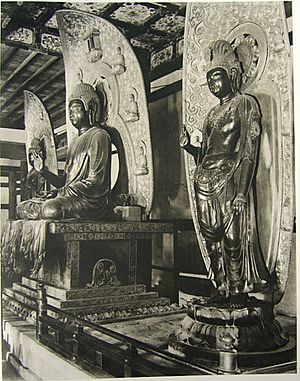Kyōroku facts for kids
The Kyōroku (享禄) era was a special way of counting years in Japan. It came after the Daiei era and before the Tenbun era. This period lasted from August 1528 to July 1532. During these years, the emperor of Japan was Go-Nara.
Key Events of the Kyōroku Era
Important Changes in Japan
- 1528 (Kyōroku 1): A big fire damaged Yakushi-ji, a famous temple in Nara. This temple is known for its beautiful statues.
- 1528 (Kyōroku 1): Konoe Tanye became the Minister of the Left (sadaijin). This was a very important government job, like being a top advisor to the emperor.
- 1529 (Kyōroku 2): Wang Yangming, a famous thinker and teacher from China, passed away. He taught about a philosophy called Neo-Confucianism, which was important in Japan too.
- 1530 (Kyōroku 3, 7th month): Kiyusho Hisatsune died at 63 years old. He had held the high office of Chancellor (kampaku). The Chancellor was the chief advisor to the emperor, even more powerful than the Minister of the Left.
- 1531 (Kyōroku 4): The Kamakura shogunate office of Governor (shugo) was ended. A shugo was like a military governor who controlled a province. Ending this office meant a big change in how Japan was ruled.
- 1532 (Kyōroku 5): Followers of the Ikko sect, a Buddhist group, were forced to leave Kyoto. They then moved and settled in Osaka, which became an important center for them.
Related Information
- Muromachi period: The Kyōroku era was part of this larger historical period in Japan.
- National Diet Library, "The Japanese Calendar" -- historical overview plus illustrative images from library's collection: You can learn more about how Japanese eras work here.
| Kyōroku | 1st | 2nd | 3rd | 4th | 5th |
|---|---|---|---|---|---|
| 1528 | 1529 | 1530 | 1531 | 1532 |
| Preceded by: Daiei |
Era or nengō: Kyōroku |
Succeeded by: Tenbun |

All content from Kiddle encyclopedia articles (including the article images and facts) can be freely used under Attribution-ShareAlike license, unless stated otherwise. Cite this article:
Kyōroku Facts for Kids. Kiddle Encyclopedia.

